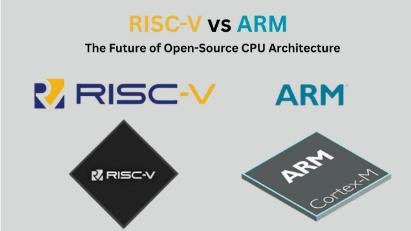For a long time, ARM and Intel have been the biggest players in the market, but RISC-V is making major waves. Its open-source instruction set architecture (ISA) is revolutionizing how semiconductors are made. This fifth-generation RISC design, which is pronounced “risk-five,” originates from UC Berkeley and swiftly spread around the world. It allows developers and businesses more freedom and flexibility to create than ever before.
RISC-V is not like other ISAs because it is open and doesn’t levy royalties. ARM and Intel’s x86 architectures make closed environments and demand pricey licenses. RISC-V, on the other hand, lets anyone design, change, and make processors that are exactly what they need, without the usual limits. This democratization kicks off a vibrant cycle of new ideas that helps individuals come up with solutions that are just right for everything from tiny embedded devices to AI-powered supercomputers in terms of power, performance, and cost.
RISC-V’s design works well because it is made up of modules. It includes a basic set of instructions and chip makers can add other features if they want to. For example, SiFive manufactures chips that are particularly specific to automobiles and edge computing. Alibaba’s Xuantie processors exploit RISC-V’s flexibility to incorporate powerful AI and IoT functions. This flexibility, which doesn’t come with a lot of extra features, is considerably different from the rigidness that is common in proprietary chip architectures.
This change is being pushed by RISC-V International, a nonprofit entity. It manages a collaborative ecosystem with more than 4,500 members and supports billions of chips that have been sent out. This attitude of working together speeds up the development of new technologies, lowers prices, and makes it less likely that vendors would lock you in. It changes how CPUs are made and utilized all around the world. Many large Linux distributions and corporations also embrace the open ISA, which illustrates how well the architecture is performing in next-generation computing.
RISC-V is a great choice for AI, IoT, and edge computing since it is open, versatile, and affordable. It lets developers break free from traditional restrictions and design processors that meet their needs, which speeds up and expands the scope of development. RISC-V shows how working together openly can make powerful groups less powerful and influence what computers can do for years to come as technology develops.
—
**Key Things to Know About RISC-V:
– An ISA that is free and open-source, so processors can be changed without having to pay for a license. It began at UC Berkeley and is now run by RISC-V International, which has thousands of members from all around the world. A modular design with a modest set of base instructions and bespoke extensions that can be used for a variety of tasks
– A lot of embedded systems, AI, IoT, automobiles, edge computing, and high-performance servers use it. Supported by well-known chip companies like SiFive, Alibaba, Espressif, and the Raspberry Pi Foundation
– Promotes fresh ideas by building a community that is accessible to everyone and not owned by one company. This makes it easy to swap vendors and speeds up development.
– Making it easy to use open-source software platforms like major Linux distributions will make hardware and software operate better together.
As the chip industry moves away from traditional gatekeepers, RISC-V’s open openness and technical flexibility speak to a very bright and open future for new ideas in processor architecture.





